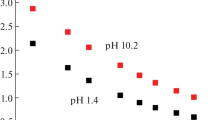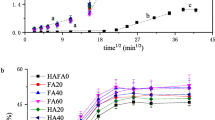Abstract
Humic substances constitute the major organic fractions of soils, sediments and natural waters, and play a dominant role in the binding, mobilization, transport and ultimate fate of organic contaminants in subsurface systems. In this paper, two humic acid samples, Guanting and Tianjin, with different origin and chemical compositions have been investigated with AFM imaging for their adsorption and aggregation behaviors on mica. While the Tianjin humic sample is found to form small spheres with 250 to 330 nm in diameter at lower concentrations, irregular loop-chain assemblies of hundreds of nanometer in diameter with the chain width of about 40 nm are dominant for the Guanting humic sample, which may attribute to the more polar aliphatic fractions in the chemical composition in the latter. The heterogeneous and polydisperse nature of humic substances with multiple structural features, such as sponge-like structures, perforated sheets, aggregate of spheres, branches and chain-like assemblies etc., is apparent at higher concentrations for both humic samples, showing morphologically new evidence for the dominant view of the humic dual-mode sorption model. With naphthalene introduced, the assemblies of Guanting humic substances clearly become more compact with significantly narrowed branches and less porous the perforated sheet-like structures. It is indicative of that smaller nanometer scale rings present along the perforated assemblies could potentially represent hydrophobic domains, which may facilitate the adsorption and aggregation of naphthalene onto the natural particle surfaces and therefore lead to an important role of dissolved humic substances in the sorption of environmental pollutants.
Similar content being viewed by others
References
Hayes M H B, Clapp C E. Humic substances: Considerations of compositions, aspects of structure, and environmental influences. Soil Science, 2001, 166(11): 723–737
MacCarthy P. The principles of humic substances. Soil Science, 2001, 166(11): 738–751
Swift R S. Macromolecular properties of soil humic substances: Fact, fiction, and opinion. Soil Science, 1999, 164(11): 790–802
Wershaw R L. Molecular aggregation of humic substances. Soil Science, 1999, 164(11): 803–813
Tombacz E. Colloidal properties of humic acids and spontaneous changes of their colloidal state under variable solution conditions. Soil Science, 1999, 164(11): 814–824
Tipping E, Higgins D C. The effect of adsorbed humic substances on the colloid stability of haematite particles. Colloid Surf, 1982, 5(2): 85–92
Wilkinson K J, Nègre J C, Buffle J. Coagulation of colloidal material in surface waters: The role of natural organic matter. J Contam Hydrol, 1997, 26(1–4): 229–243
Garbarini D R, Lion L W. Influence of the nature of soil organics on the sorption of toluene and trichloroethylene. Environ Sci Technol, 1986, 20(12): 1263–1269
Gauthler T D, Seitz W R, Grant C L. Effects of structural and compositional variations of dissolved humic materials on pyrene KOC values. Environ Sci Technol, 1987, 21(3): 243–248
Chiou C T, Malcolm R L, Brinton T I, et al. Water solubility enhancement of some organic pollutants and pesticides by dissolved humic and fulvic acids. Environ Sci Technol, 1986, 20(5): 502–508
Chiou C T, Kile D E, Brinton T I, et al. A comparison of water solubility enhancements of organic solutes by aquatic humic materials and commercial humic acids. Environ Sci Technol, 1987, 21(12): 1231–1234
Rutherford D W, Chiou C T, Kile D E. Influence of soil organic matter composition on partition of organic compounds. Environ Sci Technol, 1992, 26(2): 336–340
Grathwohl P. Influence of organic matter from soils and sediments from various origins on the sorption of some chlorinated aliphatic hydrocarbons: Implications on KOC correlations. Environ Sci Technol, 1990, 24(11): 1687–1693
Murphy E M, Zachara J M, Smith S C, et al. Interaction of hydrophobic organic compounds with mineral-bound humic substances. Environ Sci Technol, 1994, 28(7): 1291–1299
Huang W L, Weber W J Jr. A distributed reactivity model for sorption by soils and sediments. 10. Relationships between desorption, hysteresis, and the chemical characteristics of organic domains. Environ Sci Technol, 1997, 31(9): 2562–2569
Engebretson R R, von Wandruszka R. Kinetic aspects of cationenhanced aggregation in aqueous humic acids. Environ Sci Technol, 1998, 32(4): 488–493
Ghosh K, Schnitzer M. Macromolecular structures of humic substances. Soil Science, 1980, 129(5): 266–276
Camerson R S, Thomton B K, Swift R S, et al. Molecular weight and shape of humic acid from sedimentation and diffusion measurements on fractionated extracts. Journal of Soil Science, 1972, 23: 394–408
Cornel P K, Summers R S, Roberts P V. Diffusion of humic acid in dilute aqueous solution. J Colloid Interface Sci, 1986, 110(1): 149–164
Engebretson R R, von Wandruszka R. Microorganization in dissolved humic acids. Environ Sci Technol, 1994, 28(11): 1934–1941
Lobartini J C, Tan K H. Differences in humic acid characteristics as determined by carbon-13 nuclear magnetic resonance, scanning electron microscopy, and infrared analysis. Soil Sci Soc Am J, 1988, 52(1): 125–130
Hatcher P G, Dria K J, Kim Sunghwan, et al. Modern analytical studies of humic substances. Soil Sci, 2001, 166(11): 770–794
Zhou Y M, Liu R X, Tang H X. Kinetics study of aqueous sorption of phenanthrene to humic acids and sediments. J Environ Sci, 2004, 16(3): 408–413
Chen Y, Schnitzer M. Scanning electron microscopy of a humic acid and of a fulvic acid and its metal and clay complexes. Soil Sci Soc Am J, 1976, 40(5): 682–686
Stevenson I L, Schnitzer M. Transmission electron microscopy of extracted fulvic and humic acids. Soil Science, 1982, 133(3): 179–185
Paredes J I, Martínez-Alonso A, Tascón J M D. Application of scanning tunneling and atomic force microscopies to the characterization of microporous and mesoporous materials. Microporous Mesoporous Mat, 2003, 65(2–3): 93–126
Heil D, Sposito G. Organic matter role in illitic soil colloids flocculation (III): Scanning force microscopy. Soil Sci Soc Am J, 1995, 59(1): 266–269
Gerin P A, Dufrêne Y F. Native surface structure of natural soil particles determined by combining atomic force microscopy and X-ray photoelectron spectroscopy. Colloid Surf B-Biointerfaces, 2003, 28(4): 295–305
Namjesnik-Dejanovic K, Maurice P A. Atomic force microscopy of soil and stream fulvic acids. Colloid Surf A-Physicochem Eng Asp, 1997, 120(1–3): 77–86
Maurice P A, Namjesnik-Dejanovic K. Aggregate structures of sorbed humic substances observed in aqueous solution. Environ Sci Technol, 1999, 33(9): 1538–1541
Wilkinson K J, Balnois E, Leppard G G, et al. Characteristic features of the major components of freshwater colloidal organic matter revealed by transmission electron and atomic force microscopy. Colloid Surf A-Physicochem Eng Asp, 1999, 155(2–3): 287–310
Balnois E, Wilkinson K J, Lead J R, et al. Atomic force microscopy of humic substances: Effects of pH and ionic strength. Environ Sci Technol, 1999, 33(21): 3911–3917
Plaschke M, Römer J, Klenze R, et al. In situ AFM study of sorbed humic acid colloids at different pH. Colloid Surf A-Physicochem Eng Asp, 1999, 160(3): 269–279
Plaschke M, Römer J, Klenze R. Influence of europium (III) on the adsorption of humic acid onto mica studied by AFM. Surf Interface Anal, 2000, 30(1): 297–300
Plaschke M, Rothe J, Schäfer T, et al. Combined AFM and STXM in situ study of the influence of Eu(III) on the agglomeration of humic acid. Colloid Surf A-Physicochem Eng Asp, 2002, 197(1–3): 245–256
Liu A G, Wu R C, Eschenazi E, et al. AFM on humic acid adsorption on mica. Colloid Surf A-Physicochem Eng Asp, 2000, 174(1–2): 245–252
Liu Y, Wang Y X, Mo H J, et al. Effect of organic substrate on the formation of extracellular polymeric substrates in activated sludge. Environmental Chemistry (in Chinese), 2004, 23(3): 252–257
Schnitzer M. Organic matter extraction. In: Page A L, ed. Methods of Soil Analysis. Part 2. 2nd ed. Madison: American Society of Agronomy, 1982. 581
Zhou Y M. Sorption mechanisms of polycyclic aromatic hydrocarbons onto natural particles. Dissertation for the Doctoral Degree (in Chinese). Research Center for Eco-Environmental Sciences, 2003
Hendershot W H, Duquette M. A simple barium chloride method for determining cationic exchange capacity and exchangeable cations. Soil Sci Soc Am J, 1986, 50: 605–608
Conte P, Piccolo A. Conformational arrangement of dissolved humic substances: Influence of solution composition on association of humic molecules. Environ Sci Technol, 1999, 33(10): 1682–1690
Karickhoff S W, Brown D S, Scott T A. Sorption of hydrophobic pollutants on natural sediments. Water Res, 1979, 13(3): 241–248
Chiou C T, Porter P E, Schmedding D W. Partition equilibria of nonionic organic compounds between soil organic matter and water. Environ Sci Technol, 1983, 17(4): 227–231
Kile D E, Chiou C T, Zhou H D, et al. Partition of nonpolar organic pollutants from water to soil and sediment organic matters. Environ Sci Technol, 1995, 29(5): 1401–1406
Chiou C T, Mcgroddy S E, Kile D E. Partition characteristics of polycyclic aromatic hydrocarbons on soils and sediments. Environ Sci Technol, 1998, 32(2): 264–269
Chiou C T, Kile D E. Deviations from sorption linearity on soils of polar and nonpolar organic compounds at low relative concentrations. Environ Sci Technol, 1998, 32(3): 338–343
Kile D E, Wershaw R T, Chiou C T. Correlation of soil and sediment organic matter polarity to aqueous sorption of nonionic compounds. Environ Sci Technol, 1999, 33(12): 2053–2056
Chiou C T, Kile D E, Rutherford D W, et al. Sorption of selected organic compounds from water to a peat soil and its humic acid and humin fractions: Potential sources of the sorption nonlinearlity. Environ Sci Technol, 2000, 34(7): 1254–1258
Zhu L Z, Chen B L, Tao S, et al. Interaction of organic contaminants with mineral-adsorbed surfactants. Environ Sci Technol, 2003, 37(17): 4001–4006
Murphy E M, Zachara J M, Smith S C. Influence of mineral-bound humic substances on the sorption of hydrophobic organic compounds. Environ Sci Technol, 1990, 24(10): 1507–1516
McGinley P M, Katz L E, Weber W J Jr. A distributed reactivity model for sorption by soils and sediments. 2. Multicomponent systems and competitive effects. Environ Sci Technol, 1993, 27(8): 1524–1531
Haggerty R, Gorelick S M. Multiple-rate mass transfer for modeling diffusion and surface reactions in media with pore-scale heterogeneity. Water Resour Res, 1995, 31(10): 2383–2400
Xia G S, Ball W P. Adsorption-partitioning uptake of nine low-polarity organic chemicals on a natural sorbent. Environ Sci Technol, 1999, 33(2): 262–269
Xia G S, Ball W P. Polanyi-based models for the competitive sorption of low-polarity organic contaminants on a natural sorbent. Environ Sci Technol, 2000, 34(7): 1246–1253
Xia G S, Pignatello J J. Detailed sorption isotherms of polar and apolar compounds in a high-organic soils. Environ Sci Technol, 2001, 35(1): 84–94
Weber W J Jr, Huang W L. A distributed reactivity model for sorption by soils and sediments. 4. Intraparticle heterogeneity and phase-distribution relationships under nonequilibrium conditions. Environ Sci Technol, 1996, 30(3): 881–888
Author information
Authors and Affiliations
Corresponding author
Rights and permissions
About this article
Cite this article
Ge, X., Zhou, Y., Lü, C. et al. AFM study on the adsorption and aggregation behavior of dissolved humic substances on mica. SCI CHINA SER B 49, 256–266 (2006). https://doi.org/10.1007/s11426-006-0256-1
Received:
Accepted:
Issue Date:
DOI: https://doi.org/10.1007/s11426-006-0256-1




